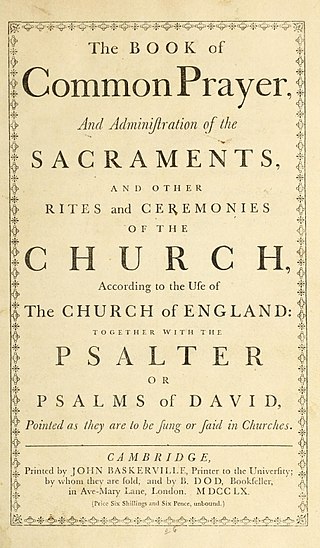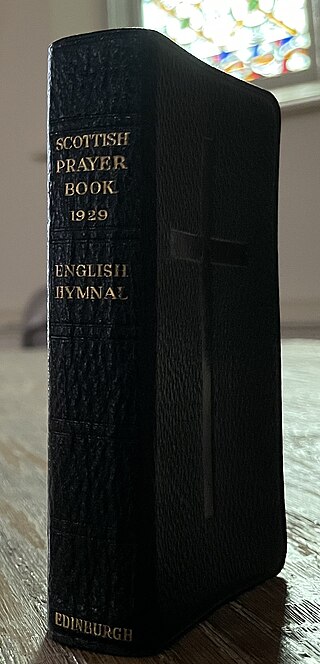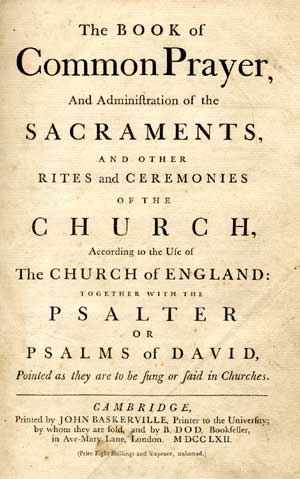
The Book of Common Prayer (BCP) is the name given to a number of related prayer books used in the Anglican Communion and by other Christian churches historically related to Anglicanism. The first prayer book, published in 1549 in the reign of King Edward VI of England, was a product of the English Reformation following the break with Rome. The work of 1549 was the first prayer book to include the complete forms of service for daily and Sunday worship in English. It contained Morning Prayer, Evening Prayer, the Litany, and Holy Communion and also the occasional services in full: the orders for Baptism, Confirmation, Marriage, "prayers to be said with the sick", and a funeral service. It also set out in full the "propers" : the introits, collects, and epistle and gospel readings for the Sunday service of Holy Communion. Old Testament and New Testament readings for daily prayer were specified in tabular format as were the Psalms and canticles, mostly biblical, that were provided to be said or sung between the readings.

Jonathan Mayhew Wainwright I was a provisional Episcopal bishop in Manhattan, New York City.

Samuel Seabury was the first American Episcopal bishop, the second Presiding Bishop of the Episcopal Church in the United States of America, and the first Bishop of Connecticut. He was a leading Loyalist in New York City during the American Revolution and a known rival of Alexander Hamilton.

The Reformed Episcopal Church (REC) is an Anglican church of evangelical Episcopalian heritage. It was founded in 1873 in New York City by George David Cummins, a former bishop of the Protestant Episcopal Church.

Horatio Potter, was an educator and the sixth bishop of the Episcopal Diocese of New York.

The Spanish Reformed Episcopal Church, also translated as Reformed Episcopal Church of Spain, or IERE is the church of the Anglican Communion in Spain. It was founded in 1880 and since 1980 has been an extra-provincial church under the metropolitan authority of the Archbishop of Canterbury. Its cathedral is the Anglican Cathedral of the Redeemer in Madrid.

Anglican eucharistic theology is diverse in practice, reflecting the comprehensiveness of Anglicanism. Its sources include prayer book rubrics, writings on sacramental theology by Anglican divines, and the regulations and orientations of ecclesiastical provinces. The principal source material is the Book of Common Prayer, specifically its eucharistic prayers and Article XXVIII of the Thirty-Nine Articles. Article XXVIII comprises the foundational Anglican doctrinal statement about the Eucharist, although its interpretation varies among churches of the Anglican Communion and in different traditions of churchmanship such as Anglo-Catholicism and Evangelical Anglicanism.

Benjamin Treadwell Onderdonk was the Bishop of the Episcopal Diocese of New York from 1830 to 1861.

Henry Ustick Onderdonk was the second Episcopal bishop of Pennsylvania.

The Episcopal Church, based in the United States with additional dioceses elsewhere, is a member church of the worldwide Anglican Communion. It is a mainline Protestant denomination and is divided into nine provinces. The presiding bishop of the Episcopal Church is Michael Bruce Curry, the first African American bishop to serve in that position.

Clement Moore Butler (1810–1890) was an Episcopal priest, author, and seminary professor who served as Chaplain of the Senate from 1850 to 1853.
Arthur Carey was an Episcopal churchman known for his support of the Oxford Movement. His controversial ordination sparked heated debate not only within the Episcopal Church but in the United States in general.
Charles Wheatly (1686–1742) was an English clergyman, known for writings on the Book of Common Prayer.

The 1979 Book of Common Prayer is the official primary liturgical book of the U.S.-based Episcopal Church. An edition in the same tradition as other versions of the Book of Common Prayer used by the churches within the Anglican Communion and Anglicanism generally, it contains both the forms of the Eucharistic liturgy and the Daily Office, as well as additional public liturgies and personal devotions. It is the fourth major revision of the Book of Common Prayer adopted by the Episcopal Church, and succeeded the 1928 edition. The 1979 Book of Common Prayer has been translated into multiple languages and is considered a representative production of the 20th-century Liturgical Movement.

The 1929 Scottish Prayer Book is an official liturgical book of the Scotland-based Scottish Episcopal Church. The 1929 edition follows from the same tradition of other versions of the Book of Common Prayer used by the churches within the Anglican Communion and Anglicanism generally, with the unique liturgical tradition of Scottish Anglicanism. It contains both the forms of the Eucharistic liturgy and Daily Office, as well as additional public liturgies and personal devotions. The second major revision of the Book of Common Prayer following the full independence of the Scottish Episcopal Church, the 1929 Scottish Prayer Book succeeded the 1912 edition and was intended to serve alongside the Church of England's 1662 prayer book.
Benjamin Isaac Haight was a prominent Episcopal priest, author, and seminary professor of the nineteenth century, as well the first appointed Custodian of the Standard Book of Common Prayer in the United States. Haight served as professor of pastoral theology at the General Theological Seminary (GTS) in New York from 1837 to 1855.

The 1662 Book of Common Prayer is an authorised liturgical book of the Church of England and other Anglican bodies around the world. In continuous print and regular use for over 360 years, the 1662 prayer book is the basis for numerous other editions of the Book of Common Prayer and other liturgical texts. Noted for both its devotional and literary quality, the 1662 prayer book has influenced the English language, with its use alongside the King James Version of the Bible contributing to an increase in literacy from the 16th to the 20th century.

In 1845, the English-born Welsh architect Owen Jones designed an illustrated and decorated version of the 1662 Book of Common Prayer, the official prayer book of the United Church of England and Ireland. It was published in London by John Murray, with two new editions following in 1863.
Book of Common Prayer is the name given to a number of related prayer books used in the Anglican Communion.
The 1928 Book of Common Prayer was the official primary liturgical book of the U.S.-based Episcopal Church from 1928 to 1979. An edition in the same tradition as other versions of the Book of Common Prayer used by the churches within the Anglican Communion and Anglicanism generally, it contains both the forms of the Eucharistic liturgy and the Daily Office, as well as additional public liturgies and personal devotions. It was the third major revision of the Book of Common Prayer adopted by the Episcopal Church, succeeding the 1892 edition and being replaced by the 1979 Book of Common Prayer.
















